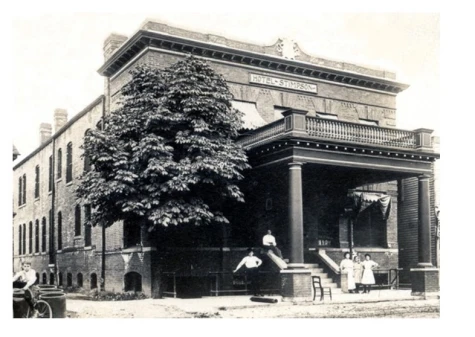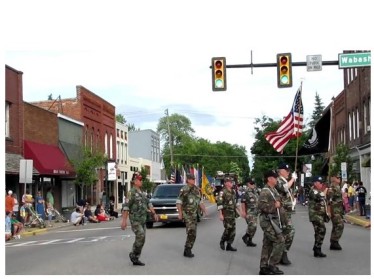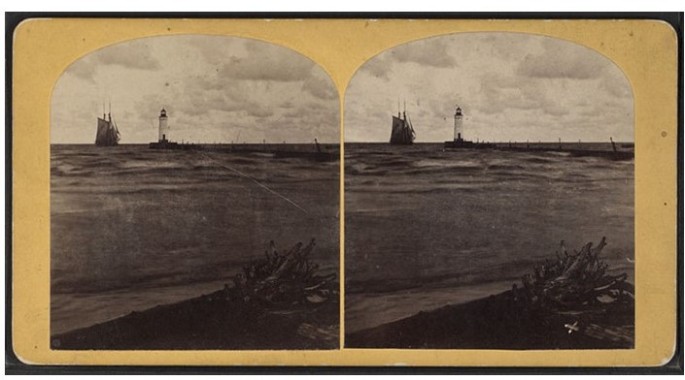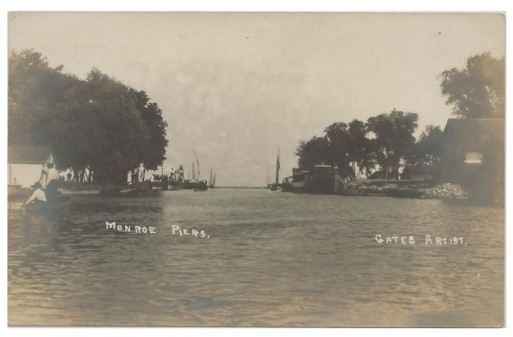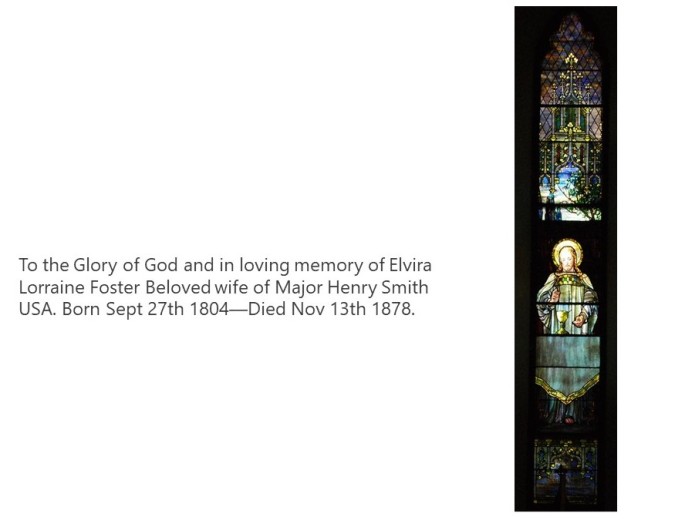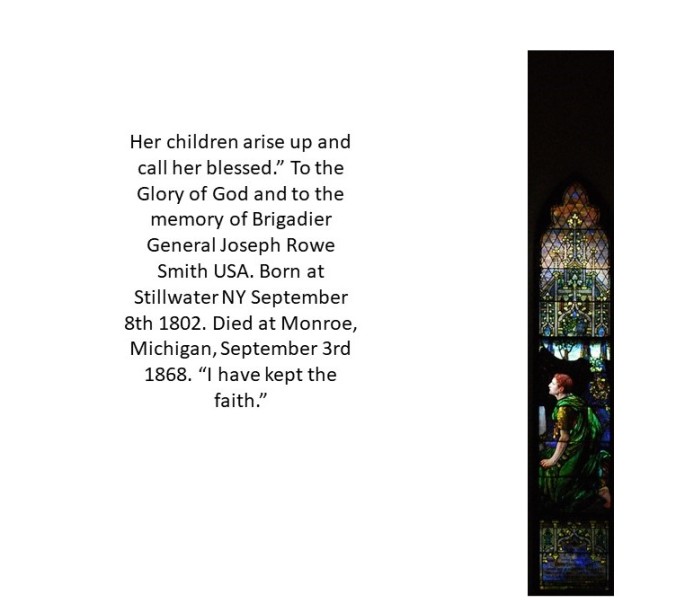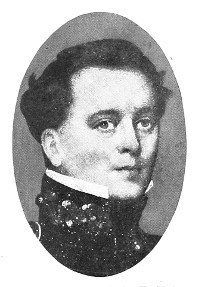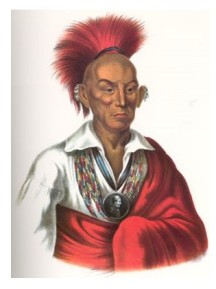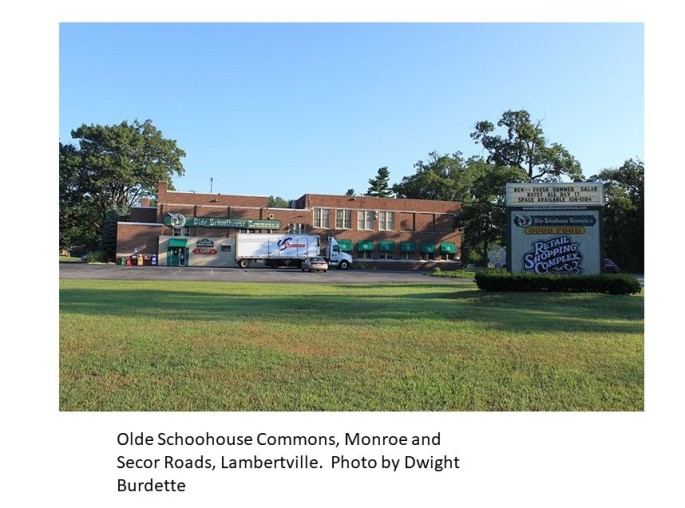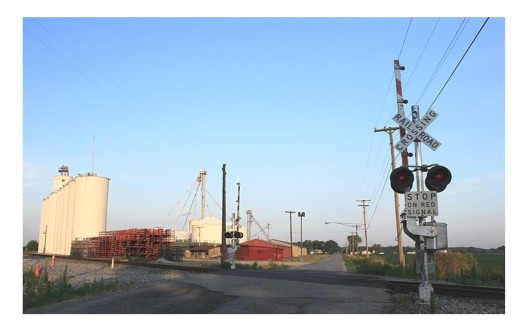
A Kentucky pond, an Alabama Railroad trestle, and four exploding steamship boilers impacted the lives of several Monroe County men as violently as the Civil War they had helped to fight and win and the Southern prison camps they had survived.
Father and Son Soldiers
The sights, smells, and sounds of home marched with Monroe County soldiers as their footsteps slowed over checkerboard fields and they turned for one last wave at family figures silhouetted in doorways. The smells of home- pigpen, hay mow, lilac bushes, blacksmith forges, bread baking, mingled into a home fire bouquet. The sounds of home, voices of mothers, fathers, sweethearts, were soon drowned out by marching feet, drills, battles, and the cries of the wounded and dying.
George A. Countryman and his son Jacob H. Countryman, of Dundee, Michigan carried the sights, smells, and sounds of home as solidly as their knapsacks from Michigan to Kentucky and Alabama battlefields and the mists over the Alabama and Cahaba Rivers near Cahaba Prison in Alabama. They both served in Company H of the 18th Michigan Infantry, Jacob enlisting on August 5, 1862, and his father George enlisting as a musician on August 10, 1862. George left his wife Margaret Gordon Countryman and their children including his daughter Margaret Theresa Countryman (Spaulding) tending the home hearth back in Dundee. According to the newspaper account of his death, Jacob eventually had a wife and two children, but records show that he enlisted at 18 years old as a single man. [1]
In the last weeks of September 1862, George and Jacob Countryman and a number of their comrades in the 18th Michigan Infantry were determined to defeat the Confederate Rebels in Kentucky and go home to their families. They found themselves facing equally determined Confederate soldiers in skirmishes at Athens and Sulphur Creek Trestle in Alabama and at Snow’s Pond in Kentucky.
Captured in Kentucky and Alabama

The Snow’s Pond skirmish, one of only two to take place between Union and Confederate soldiers in Boone County, Kentucky, erupted on September 25, 1862, when Confederates General Kirby-Smith and Colonel Basil Duke with the backing of John Hunt Morgan’s Second Kentucky Cavalry followed their orders to slow the Union forces as they moved South.
Union General Henry M. Judah and his Union soldiers advanced into Kentucky, occupying positions between Florence and Falmouth and camping around Snow’s Pond. On September 25, 1862, Colonel Basil Duke’s Confederate soldiers raided the Union camps in Walton and a little North of Snow’s Pond, capturing about 65 Union prisoners.
In a letter dated September 25, 1862, Brigadier General Quincy A. Gillmore reported what happened near Snow’s Pond Kentucky to his fellow Brigadier General A.J. Smith who commanded the U.S. forces near Covington, Kentucky. General Gillmore reported an attack on Union lines at 11 o’clock that morning by over 500 rebel cavalry with one field piece. The Confederates attacked pickets, capturing several small posts.
Fifty Union soldiers were missing. General Gillmore wrote that “I am in hopes that some of them will make their appearance. They disappeared (as suddenly as they came up) toward Crittenden. I learned their number from parties who met them on the Crittenden road. It is doubtless the identical party that I have heard of before, numbering 508. I am gratified that more cavalry are coming, and I wish they were here now. It is next to impossible to resist these sudden dashes with infantry, and my pickets will be in constant danger of being driven in unless I have enough mounted force to scour the country for miles around. “
Very respectfully, your obedient servant,
Q. A. Gillmore
Brigadier-General, Commanding [2]
According to Record of Service of Michigan Volunteers in the Civil War, George, Joel, and Jacob Countryman were captured at the skirmish at Snow’s Pond and paroled shortly after the battle. It is certain that George Countryman rejoined his regiment because the Adjutant General’s Report states that George Countryman was taken prisoner at Athens and he is listed as one of the prisoners at Cahaba. He was exchanged on April 22, 1865 at Vicksburg, Mississippi. He survived the Sultana disaster and was treated at Washington for scalds to his head and shoulder, and he was discharged June 22, 1865, at Detroit, Michigan. [3]
On Thursday, October 2, 1862, the Monroe Commercial reported that about 400 Rebel Cavalrymen captured 53 soldiers from 18th Michigan Infantry while the soldiers were on picket duty on the road from Covington to Louisville, Kentucky. Jacob H. Countryman of Dundee and Joel Countryman of Dundee were on the list of captured soldiers. Jacob and Joel are not listed in the Cahaba records, but it is reasonable to assume that they too rejoined their regiment and might have been at Athens. Their records state they were taken prisoner and paroled shortly after the battle and both were mustered out on June 26, 1865, at Nashville, Tennessee.[4]
Sulphur Creek Trestle-Athens
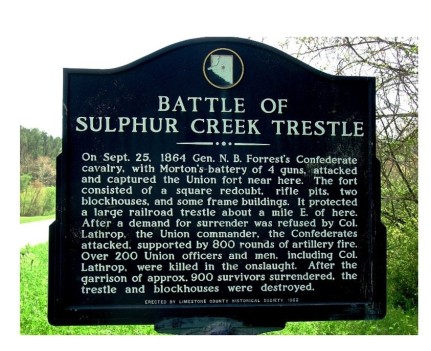
From September 23-25, 1864 Confederate and Union soldiers clashed in Limestone County Alabama, near Athens. In September 164, Confederate General Nathan Bedford Forrest mustered his cavalry force into northern Alabama and Middle Tennessee with the goal of disrupting the supply chain of General William Tecumseh Sherman’s Army in Georgia. General Bedford Forest’s soldiers advanced toward Athens on the afternoon September 23, 1864, and the two armies clashed five miles north of Athens. By evening, the Confederates controlled the town and the Union men retreated to Fort Henderson.
On the morning of September 24, 1864 with a Confederate artillery barrage as a backdrop, General Forrest convinced Union commander Colonel Wallace Campbell that his forces numbered 1,000-10,000 soldiers and that he would be wise to surrender. Colonel Campbell surrendered the fort and its garrison, but almost as soon as he surrendered Jonas Elliott and his force of approximately 350 men from the 18th Michigan and 102nd Ohio regiments arrived on the train from Decatur to reinforce him. Another battle took place, and after the Union regiments suffered over 100 casualties they surrendered to the Confederates.[5]
After his victory at Athens, General Nathan Bedford Forrest advanced about six miles north of the town along the railroad, with the goal of destroying a strategic trestle at Sulphur Creek. A force of 1,000 Union soldiers, a fort, and two blockhouses guarded the Sulphur Creek trestle.
Confederates manned their artillery and bombarded the fort at Sulphur Creek trestle on the morning of September 25th, 1864, and since the Union soldiers had built the fort below the tops of the surrounding hills the fort couldn’t withstand the bombardment. At least 200 Union soldiers, including their commander, Colonel William Hopkins Lathrop, were killed and the remaining 900 soldiers had surrendered by noon. After destroying the trestle and blockhouses, the Confederates reported no losses. They transferred the Union prisoners to prisons at Macon and Andersonville, Georgia, and Cahaba, Alabama[6]
Detained at Cahaba Prison
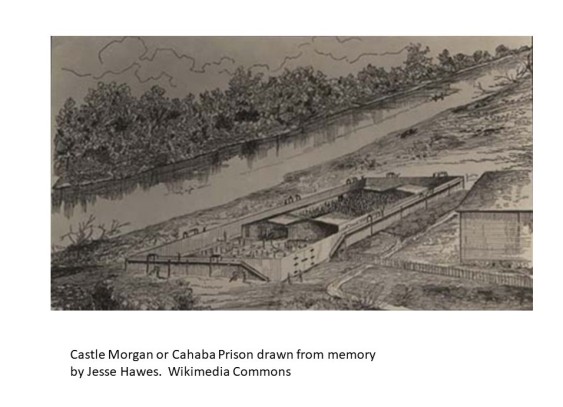
In the 1850s, when Colonel Samuel M. Hill built a red brick warehouse as a part of a group of storage buildings for the Cahaba, Marion, and Greensborough Railroad, he didn’t visualize it crowded with Union prisoners. After the railroad failed in the 1850s, he abandoned the warehouse, but by the summer of 1862, Confederate authorities had visualized a prison in the warehouse. By January 1864, the Confederates were well along in their plans for a permanent prison at Cahaba.
Cahaba warehouse-prison stood on the banks of the Alabama and Cahaba Rivers in the east end of the city of Cahaba, Alabama. Originally planned to hold 500 prisoners, over 5,000 Union soldiers had been packed inside its high brick walls and twelve-foot-high wide plank fence between 1863 and 1865. A leaky roof covered its 15,000 square foot main building and four open windows coaxed pale sun light inside that scattered designs on the bare earthen floor. Other decrepit buildings provided little shelter from the weather.
The prison yard, measuring about 35×46 feet, served as an exercise and gathering place for prisoners and also functioned as the cook yard. Guards paced the elevated walkway that extended around the outside fence and two small cannons protruding from two portholes in the north end of the stockade wall backed up the guards.
Prisoners lived in buildings without bedding, sleeping on bare floors and trying to keep warm from the heat of one fireplace. The buildings couldn’t be centrally heated, so the Confederates allowed open fires on the floors. An artesian well, located 200 yards outside of the prison wall, provided water for the prisoners. An open trench ran from the well which was extremely polluted by sewer runoff from the town and the prison itself ran into the prison. Several prisoners later wrote that the rivers flooded often, covering the building floors to a depth of one to four feet.
.Two men ran the prison, Captain H.A.M. Henderson, a Methodist minister, and Lt. Colonel Sam Jones. Living his Christian principles, Captain Henderson treated prisoners fairly, earning a low Cahaba death rate compared to most of the other Confederate prison camps. During Captain Henderson’s tenure, Confederate authorities established a hospital at the Bell Tavern Hotel, two blocks away from the prison to combat the increasing rate of sickness. The most common illnesses were scurvy, dysentery, and chronic diarrhea. Even with a hospital, lice, rats, and dysentery caused problems for the prisoners. Access to medical supplies, firewood, and food contributed to the lower death rate of the Cahaba prisoners.
Finally, the Union prisoners at Cahaba received some joyful news. General Lee had surrendered at Appomattox. The War had ended and they were going home. They boarded a steamer called the Sultana docked in Memphis, Tennessee, most counting the hours until the Mississippi currents carried them North
William N. Goodrich Tells His Story
William N. Goodrich was born in Whiteford Township, Monroe County, Michigan, on November 21, 1842. He enlisted in Company E of the 18th Michigan Infantry on July 31, 1862. After spending some time in camp at Hillsdale, the regiment tramped through Kentucky, spending the winter at Lexington. In April-May of 1863, the soldiers boarded railroad cars to the front, but only got as far as Nashville, Tennessee. At Nashville, William said that they spent two or three days in the “Zollicoffer Building,” killing lice that were thicker than fleas on a dog. From the Zollicoffer Building the soldiers went into camp for a “long year,” until the welcome news came that they were finally being ordered to the front. He wrote in his Sultana survivor memoir that sometime in May or June 1864, they arrived at Decatur, Alabama in the night and pitched their tents just outside the city.
William reported that “ On the 23d of September it was reported that a band of “Johnnies” were tearing up the track near Athens, Ala., and a detail of about 400 men was made from our brigade and boarded a train of flat cars some time in the night. Crossing the river and waiting until daylight, we then proceeded as far as we could on the cars, then going on foot for a short distance we were suddenly fired upon by the enemy. The firing was returned by us and the enemy fled. Our orders were to go to Athens, so we went on. Getting in sight of Athens, what did we see? “Johnnies” all around us. Hundreds of them in our front and rear. We fought with them the best we could and tried to get to the fort, as our dear old stars and stripes were still flying. But alas! as we had got almost there the gates swung open and out marched our boys in blue. What could we do but surrender? It was with long faces that a flag of truce was sent to the commander that we had surrendered. Soon we were surrounded by the “Johnnies,” asking for something to eat. It seemed to me as though they were about starved, and we soon found that our captor was Gen. Forrest. When I heard this I thought my time had come, as the massacre at Fort Pillow was fresh in my memory.
We did not remain long at Athens but were hurried off to a Southern prison, Cahaba, Ala., where we were fed on corn meal for almost six months when the glad news came that we were to leave; some thought for Andersonville, others thought for home. It proved to be the latter. After riding in dirty box cars and then marching, we arrived at Big Black river on the 21st of March, 1865, and remained in camp, which was four miles from Vicksburg, for three or four weeks. Then the glad news came that we were to go North and be exchanged. We marched to Vicksburg and went on board the steamer Sultana.” [7]
The Sultana Explodes and Sinks

The facts about the sinking of the Sultana are as stark as the conditions of the Andersonville and Cahaba prison camps where the paroled Union soldiers had spent the remainder of the war. The soldiers were war casualties-sick, starved, and often tortured- before they boarded the Sultana. In fact, they crowded the decks to creaking because they were desperate to reach northern hospitals for treatment or yearning to reach homes and people they hadn’t seen for painful years. Many of the soldiers were walking skeletons, and many boarded in litters carried by faithful friends.
Michigan Poet Will Carleton graphically described the paroled Union soldiers in his poem, “The Sinking of the Sultana”:
On her decks, all bright and smiling, stood a band of haggard men,
Who had smarted, prayed, and fasted in gaunt hunger’s dreariest den;
Who had tasted war’s hard fortunes, in a hostile prison pen.[8]
The soldiers kept climbing aboard the Sultana, even when Captain J. Cass Mason announced that the ship was overloaded and he could not board another soldier. The bright and smiling haggard men were anxious to start their journey home as quickly as they could. They ignored Captain Mason.
Captain Mason had already established a controversial career before he became captain of the Sultana. His wife, Rowena M. Dozier, belonged to a prominent St. Louis family, and his father-in-law was a prominent southern sympathizer. The Federal government confiscated Captain Mason’s steamer Rowena in February 1863 for smuggling Confederate contraband and he severed the relationship with his father-in-law, James Dozier, and all Confederates after that. He became the captain of the Belle Memphis and earned a reputation as careful riverboat pilot which lasted until the Sultana explosion. Built in Cincinnati in 1862, Captain Mason and a few investors purchased the Sultana in 1864, and put her to work transporting passengers and freight down the Mississippi River.
With the Civil War ended, the U.S. government made the repatriation of Union prisoners of war from the South a priority. Captain Mason saw his chance to make a profit and he readily agreed to carry Union soldiers from Southern prisons for five dollars per person and ten dollars per officer. The Sultana had a capacity to carry about 300 passengers with an additional 85 crew members.
The Sultana left the Memphis dock loaded with nearly 2,300 passengers, most of them soldiers. Although Captain Mason decried the overloading of the Sultana, he embarked with the crowded steamship determined to keep to his schedule. Several officers and crew members urged him not to continue the voyage, but when he did they stayed aboard. Some knew about the poor condition of the Sultana’s boilers, one of them even repaired with a temporary patch. When the Sultana reached a point about seven miles upriver from Memphis, the boilers exploded at about 2 o’clock on the morning of Thursday, April 27, 1865. The center sections of the steamship exploded, bursting into flames scalding soldiers and civilians alike, and throwing many of them into the water.
Accounts differ as to the number of Sultana casualties. Some accounts say that 1,500 people died, others claim 1,700 people died; others, 1,800. At least 600 of victims drowned. Captain Mason, estimated to be just 35 years old, and most of his crew perished. Survivors said that they saw Captain Mason on deck desperately trying to save passengers struggling in the water by throwing them pillows and other buoyant items that would carry them above the strong current.
Casualties and Controveries
For a time, several historic events submerged the magnitude of the sinking of the Sultana in the Mississippi River just above Memphis, Tennessee on April 27, 1865 as deeply as the ship sank into Mississippi waters. General Robert E. Lee surrendered his Confederate Army at Appomattox, Virginia on April 9, 1865, ending the Civil War. John Wilkes Booth assassinated President Abraham Lincoln on April 14, creating chaos and a manhunt for Booth and his cohorts which ended with Booth’s capture and execution on April 26, 1865. The Sultana blew up the next day, when people were still reeling from the events of the days before the latest tragedy.
The same controversy and uncertainty swirled around the casualty figures and the reasons for the demise of the Sultana and the deaths of so many Union soldiers and civilians. On May 19, 1865, Commissary General of Prisoners Brigadier General William Hoffman after investigating the sinking of the Sultana reported that 1,238 soldiers, passengers, and crew died. The Bureau of Military Justice set the death toll at 1,100. In 1880, the 51st Congress and the War Department, Pensions and Records Department estimated the Sultana losses to be 1,259. The United States Customs Service put the casualty figure at 1,547. [9]
Soldiers aboard the Sultana and others on shore spoke darkly of coal torpedoes, Confederate sabotage, and soulless wealthy men sacrificing the Sultana for a profit. The Federal Government held hearings about the Sultana and determined that Confederate sabotage did not sink the Sultana and its officers were not responsible either. They concluded that the combination of low water levels and water rising and falling between the four boilers and the faulty temporary patch to a leaky boiler caused them to explode. The report also stated that the ship’s quarter master Reuben Hatch, motivated by greed and politics, allowed the Sultana to be loaded beyond its normal capacity.
William Goodrich Continues His Story
“We were a jolly crowd, but our joy was of short duration. Everything went along smoothly until we were about eight miles above Memphis, when the explosion took place by which so many lives were lost. As for myself I had no thoughts of dying just then, so I looked around among the wreck and found a box, carried it to the side of the boat and waited until the coast was clear; then threw it overboard and jumped in after it. It seemed to me as though I was going down to the bottom, but such was not the case.
Soon coming to the surface of the water I seized the box and started down the river for shore, or any place where I could get out of the water. After floating and swimming about four miles I landed safely on a small willow tree. Soon after getting nicely fixed on the branches, making myself as comfortable as possible under the circumstances, a man by the name of Williams, of the 1st Kentucky Cavalry, came floating along and caught hold of a log that was fast to the tree. After watching him a few minutes I descended from my perch and helped him upon the log, held him there for two hours, and was rewarded by seeing him come to life again, as he was as near dead as any one I have seen who was not dead.
Early in the morning of the 27th of April boats were seen coming up the river searching for the victims of the disaster. Some of the poor fellows were hanging to the trees, some were on logs, and some were found in almost every conceivable place. At about eight o’clock I was picked up, taken on board a steamer and about twelve o’clock landed at Memphis. Remaining there four days, I again started for the north, this time with fear, thinking that we might meet with the same catastrophe, but we landed safely at Cairo, Ill., there boarded the train for “Camp Chase,” Ohio. Arriving there I remained two weeks and then was sent to my native State, where I was discharged from the service.” [10]
William N. Goodrich moved to Menominee, Michigan, after the war and worked as a mail carrier. He is buried in Riverside Cemetery, Menomonee, Michigan.
A Few Fellow Prisoners of George Countryman Captured at Athens and aboard the Sultana from Monroe County
- Jasper P. Decker. Enlisted at Whiteford, Michigan, in Company L, 1st Michigan Engineers and Mechanics. Killed. He is buried in West Adrian Cemetery, Lenawee County, Michigan.
- Charles DeLand. Whiteford. Co. K, 18th Survived the Sultana.
- Miles Frink. Milan Co. H, 18th He died in the Sultana Explosion.
- George C. Haight, age 44. Drummer in Co. D, 7th, Michigan Infantry. Buried in London Township Cemetery, London, Monroe County, Michigan. He survived the Sultana.
- Daniel Monroe. C. K, 18th Michigan Infantry. Survived the Sultana.
- Thomas Hinds. Whiteford. Co. K, 18th Killed in Sultana Explosion. He is buried in Association Cemetery, Sylvania, Lucas County, Ohio.
- Alexander Hoy. Ash, Monroe County. Co. K, 18th Michigan Infantry. He survived the Sultana explosion. He is buried in Mt. Elliott Cemetery, Detroit.
- Lemuel Lattin. Frenchtown, Monroe County. Company K, 18th He survived the Sultana explosion.
- Andrew J. McEldowney. Monroe. Company K, 18th Michigan Infantry. Killed in Sultana explosion.
- Anthony R. Metta. Monroe. Co. K, 18th Michigan Infantry. Killed in Sultana Explosion.
- Harrison D. Plank. Dundee. Co. H, 18th Killed in Sultana explosion. He is buried in Maple Grove Cemetery, Dundee.
- Alexander Poupard. Frenchtown, Monroe County. Co. K, 18th Michigan Infantry. He survived the explosion of the Sultana.
- Samuel Poupard. Frenchtown. Monroe. Co. K., 18th Michigan Infantry. He survived the Sultana. He died in 1880 and is buried in Saint Joseph Cemetery, Monroe, Michigan.
- Jacob L. Slick. Lambertville. Co. A., 18th Michigan Infantry. He survived the Sultana. He died on June 4, 1908 and he is buried in Lambertville Cemetery.
- Samuel K. Shettleroe. Vienna, Monroe County. Co. K, 18th Michigan Infantry. Survived the Sultana.
- Isodore Shettleroe. Erie, Monroe County. Co. K, 18th Michigan Infantry. Survived the Sultana. He is buried in Los Angeles National Cemetery, Los Angeles, California.
- John Shettleroe. Erie, Monroe County. Co. K, 18th Michigan Infantry. Survived the Sultana.
- David L. Snyder. Dundee. Co. H., 18th Killed in Sultana Explosion.
- George Stump. Erie, Michigan. Co. K, 18th Michigan Infantry. Survived the Sultana explosion. He moved to Toledo, Ohio and died on April 7, 1908. He is buried in Woodlawn Cemetery, Toledo, Ohio.
- Vincent Sulier. Whiteford. Co. K, 18th Survived the Sultana. Buried in Lakeview Cemetery, Gray Eagle, Minnesota.
- Abram Wiechard. Bedford, Monroe County. Co. K. 18th Michigan Infantry. Survived the Sultana.
- Nelson D. Wright. Exeter, Monroe County. K. 18th Michigan Infantry. Survived the Sultana.
This is just a partial list of Monroe and Monroe County soldiers. Soldiers from other Michigan counties and from other states including Ohio, Indiana, Pennsylvania, Tennessee, and Kentucky complete the roll of soldiers on the Sultana who were lost or saved. [11]
George and Jacob Countryman Come Home to Dundee
The 1870 United States Federal Census records that George Countryman, age 50, occupation farmer, lived in Dundee, Michigan, with his wife Margaret Countryman, 45. Their children Jacob, 25; Louisa, 23; Rosa, 11, and Cora, 8, lived with them. Their daughter Margaret born in 1852, had married Sylvanus Spaulding, Jr. in 1869.
Jacob Countryman lived at home with his parents and sisters for about seven years after he and his father returned from fighting for the Union. Marriage records show that he married Mary A. Taylor on December 14, 1872, and established his own home.
Life in Civil War camps and in Civil War prisons often snarled soldiers in the nets of alcohol and willing women and they sometimes took their habits with them into civilian life. The existence and effects of Post traumatic stress syndrome had not yet appeared on the medical horizon. Many of the returning soldiers didn’t not live happily ever after lives because their bodies had been weakened by sickness and their long imprisonments. Perhaps this is what happened to Jacob Countryman.[12]
An obituary in the archives of the Old Mill Museum in Dundee, Michigan, reveals the last chapter of Jacob Countryman’s story.
ANOTHER WHISKEY VICTIM.
Jake Countryman Killed by the Lake Shore Passenger Train.
“Jake Countryman was killed last evening by the Lake Shore train!” was the startling intelligence conveyed about town early Saturday morning last. Jake left town at about 8 o’clock that evening in his usually intoxicated condition, for his home about two miles southeast of the village. Reaching the railroad crossing of Monroe road, just east of village limits, he probably sat down beside the track for a rest, and either fell asleep or was too drunk to realize the approach of the train. He was struck upon the head and hurled several feet from the track. He was quite generally known hereabouts by his habits of dissipation, has lived here from boyhood, and was a soldier in the 18th Mich. Infantry. Leaves a wife and we believe two children, also parents. His funeral occurred Sunday.
Jacob and his father George are buried in Maple Grove Cemetery, Dundee, Michigan.
The Sultana Survives
Remnants of the Sultana survived its victims. In 1982, Memphis attorney Jerry O. Potter led a local archaeological expedition with the goal of finding the Sultana wreckage. About four miles from Memphis, Tennessee, he and his workers discovered what they believed to be the wreckage of the Sultana, when they unearthed blackened wooden deck planks and timbers about 32 feet under a soybean field on the Arkansas side of the Mississippi River. It seems fitting that the news of their discovery appears in the Blount County Dailey Times with an April dateline. [13]
A Few Books about the Sultana Disaster
Chester D. Berry. Loss of the Sultana and Reminiscences of Survivors. University of Tennessee Press, 2005.
William O. Bryant. Cahaba Prison and the Sultana Disaster. University of Alabama Press, 1990.
Jerry O. Potter. The Sultana Tragedy: America’s Greatest Maritime Disaster. Pelican Publishing, 1992.
Gene Eric Salecker. Disaster on the Mississippi: The Sultana Explosion, April 27, 1865. Naval Institute Press, 1996.
Notes
[1] A newspaper story recorded the death of Jacob Countryman on May 1, 1886. He survived Civil War battles and a Confederate POW camp, but was struck by a Lakeshore Train near his home in Dundee. He is buried in Maple Grove Cemetery, Dundee, and his obituary is on file at the Old Mill Museum in Dundee.
George Countryman is listed as a Sultana Survivor in: Loss of the Sultana and Reminiscences of Survivors, Reverend Chester D. Berry.
Another Countryman, Joel Countryman, is listed in U.S. Civil War Soldier Records and Profiles as living in Dundee, Michigan, and enlisting in Company H, 18th Michigan Infantry, at age 19. He was a prisoner of war, and survived to be mustered out on June 26, 1865 at Nashville, Tennessee.
George Countryman is buried in Maple Grove Cemetery, Dundee.
[2] The Rebellion: A Compilation of the Official Records of the Union and Confederate Armies, Vol. 1 of 2 (Classic Reprint) Paperback – July 11, 2012
[3] Record of Service of Michigan Volunteers in the Civil War, 1861-1865. Volume 18, 1th Infantry, p. 26.
[4] Monroe Commercial, Thursday, October 2, 1862, p. 3, Column 1
[5] The Battle of Sulphur Creek Trestle
[6] Alabama Historical Marker – Sulphur Creek Trestle
[7] Loss of the Sultana: Reminisces of the Survivors. Reverend Chester D. Berry.
[8] The Loss of the Sultana, A War Ballad. Will Carleton. The Hillsdale Standard, Hillsdale Michigan, January 6, 1869.
[9] Gene Salecker. Disaster on the Mississippi, the Sultana explosion April 27, 1865. Annapolis, Md: Naval Institute Press, 1996.
[10] Loss of the Sultana: Reminisces of the Survivors. Reverend Chester D. Berry.





